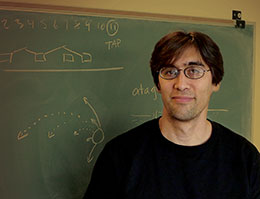Volume 31 · Number 1 · Fall 2013
Biology: the new math

Genomics data is growing so fast that storing and analyzing the data "gets harder every year," says Ian Korf, director of the UC Davis Genome Center’s Bioinformatics Core.
(Keith Bradnam/UC Davis)
One of the great challenges of genomics is “Big Data” — how to handle and analyze very large, very complex sets of information.
Thanks to new “high-throughput” technology that allows processing of large quantities of DNA, the amount of sequence data worldwide is growing at a faster rate than the memory capacity of computer hard drives that store it, said Ian Korf, director of the UC Davis Genome Center’s Bioinformatics Core and professor of molecular and cellular biology.
That makes finding a match in a database a little like searching for a needle in a haystack as more and more hay piles on. “It gets harder every year,” Korf said.
A whole new field, bioinformatics — blending biology, computer science and statistics — has grown up specifically to deal with the problems of handling biological sequence data.
That means that students who hope to pursue careers in genetics or biology research need exposure to math and programming like never before, and UC Davis is addressing this need.
In 2012–13, UC Davis offered a new genomics track within the undergraduate major in genetics. The track includes lecture classes on principles of genomics, functional genomics and comparative genomics as well as a lab class.
The lab class looks a lot more like a computer science classroom than biology class. The students learn some basic programming skills and have to work with and analyze large sets of real-world DNA data.
“We want them to be familiar with genomics methodology and have hands-on experience,” said Siobhan Brady, assistant professor of plant biology, who teaches functional genomics and the lab class.
The program is among the first of its kind in the UC system, said John Harada, a professor of plant biology who organized it. Previously, students looking to learn genomics would take special workshop classes, through the Genome Center or elsewhere.
Similarly, graduate genetics students at UC Davis now begin to learn programming in their first year. The Graduate Group in Genetics, which is preparing to change its name to Integrated Genetics and Genomics, is also attracting interest from students who already have a background in computer science, said program chair Janine LaSalle, a professor in the School of Medicine.
While doctoral students still need the basics of genetics, LaSalle said, if they want to pursue careers in genetics research they need to be comfortable with big data.
Back to "Enter the Genomics Matrix"
